A quick and easy explanation on how the surfboards are made. From hand shaped custom surfboards to molded surfboards, soft surfboards, body boards and injection molded boards. What are the advantages and disadvantages of each construction technique and who is it meant for.
There are a few main methods of constructing surfboards.
- Custom Surfboards Shaping – PU surfboards
- Machine shaped PU surfboards
- Firewire technology
- Molded Surfboards
- Soft Surfboards
- Bodyboards
- Injection Moulded Boards
Table of Contents
Custom Surfboards Shaping
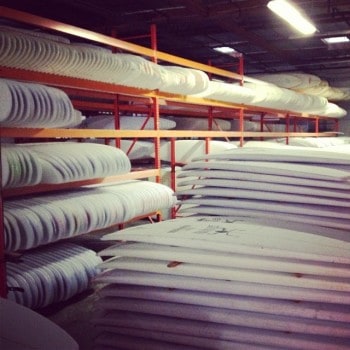
Custom surfboards are shaped from blanks.
What is a blank? Blank is a polyurethane (PU, hard foam) core in the rough shape of a surfboard which is split from nose to tail and a wooden strip, called a stringer, approx. 6mm wide is glued between the 2 halves. The stringer strengthens the board, reducing the risk of the board twisting or snapping.
Shaping a custom surfboard
The blank is then shaped by hand using a variety of tools. First a saw is used to cut the desired outline and then an electric plane is used to take off the hard outer skin of the blank and any large areas of foam that need to be removed. Extra Rocker can also be added using the power plane. A rasping tool (surform) and then sandpaper are used to fine tune the blank and give the custom surfboard its finished shape. Custom surfboard may now be spray-painted using acrylic or other paint prior to laminating.
NOTE: If you will be painting your surfboard make sure your read this how to article.
Laminating a custom surfboard
In the laminating process the surfboard is covered with woven fibreglass cloth. Shortboards usually have 1 layer of 4 oz weight cloth on the bottom and 2 layers on the deck. Longboards often use a stronger 6oz cloth and may have more layers. The cloth is then saturated with polyester or isothalic resin. After this sets and the fins have been attached (if you have glass-on fins) a coat of sanding resin is applied and when this has hardened it is sanded down to give the final shape. A further coating of resin (the gloss coat) may be given which can then be polished to a high gloss finish.
Epoxy and polystyrene foam is more and more used instead of polyester and polyurethane foam. Polystyrene foam makes the boards lighter and epoxy resin makes them stronger so epoxy surfboards are more durable, but they are still not thoroughly accepted because ‘the feel’ when riding them is different.
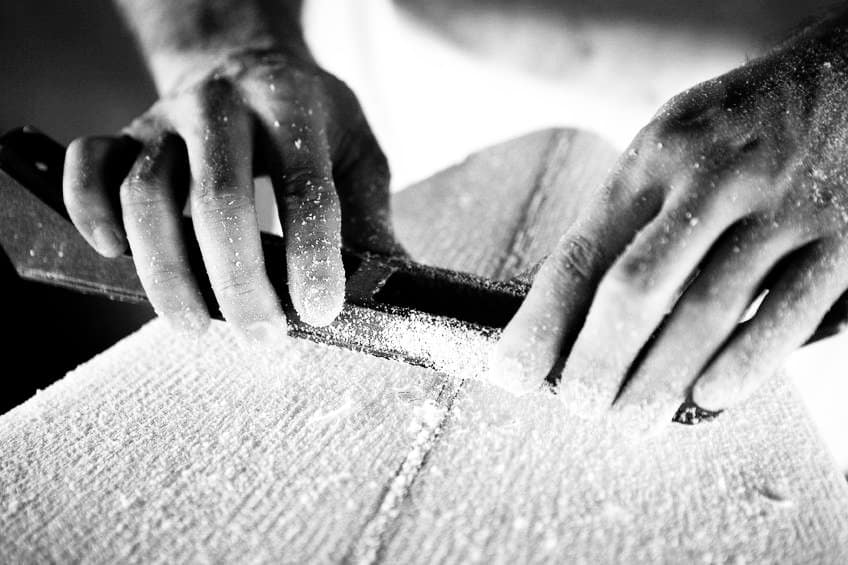
• PRO: Custom boards can be shaped to the exact requirements of the surfer, they are light and they give a high performance.
• CON: They are expensive and they ding easily.
• WHO RIDES THEM? Custom shaped surfboards are mostly meant for intermediate and experienced surfers that know what they want.
Machine shaped PU Surfboards
Machine shaped PU Surfboards are basically made the same way as custom shaped surfboards. Again instead of polyurethane foam you can use polystyrene and epoxy.
The difference is that the blank is shaped by a machine. This means that the shaping process is quicker but on the other hand, every board is completely the same. With custom shaped surfboard you can talk to the shaper about what you want, with machine shaped surfboard you can only choose from a range of pre-designed surfboard shapes.
Since machines shape automatically without measuring it can also happen that the blank is not correctly aligned while shaped and the board is not even if you measure it from the stringer.
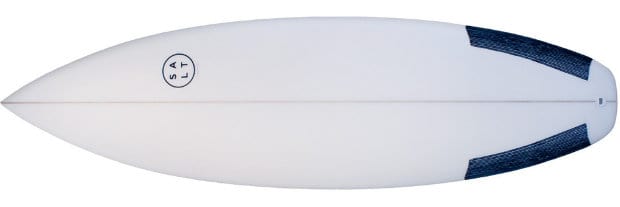
• PRO: Light, high performance, can be cheaper than custom made surfboards.
• CON: Still expensive, ding easily, you can only choose from a range of pre-designed surfboard shapes.
• WHO RIDES THEM? Machine shaped surfboards come in different shapes and sizes from shortboard to minimals etc. but are generally suited for more advanced surfers.
Firewire Technology
The original idea behind Firewire surfboards was in the rails. Surfboards usually have one stringer in the middle of the board that makes the board stronger, rails are just foam. But when you are surfing, making turns and putting pressure on the rails this is where you would need the flex – in the rails. to propel you out of turns. S Firewire put the stringer into the rails instead of in the middle of the board. Besides improved flex reinforced rails are also much less prone to damage. Most of the dings you get are on the rails and Firewire solves that.
Today Firewire is not only about rails, they are an advanced manufacturer that put lots of effort into new technologies. How are their boards made?
They use EPS (Expanded Polystyrene) foam for their cores. It is lighter (1lb vs. 2.5 – 3lb per cubic foot) and more eco friendly. EPS waste can also be recycled. They then put a 3mm layer of high density aerospace composite on top of it to stabilize the core and increase strength. They laminate this core using epoxy resins. Rails are made using balsa wood, sometimes even carbon rods.

• PRO: Light, high performance, durable.
• CON: Expensive, you can only choose from a range of pre-designed surfboard shapes (if you are not a pro surfer).
• WHO RIDES THEM? Intermediate and advanced surfers.
Surftech surfboards (Tuflite technology)
Tuflite technology is an epoxy sandwich surfboard technology. Surftech is producing some of the strongest lightweight epoxy surfboards in the world. It gives high performance and maximum durability and is used by many shapers throughout the world. Tuflite technology was introduced by Randy French in 1992 when he started Surftech. French, a shaper since the late 1960’s has been on the leading edge of surfboard design and evolution for over 30 years. His industry leading windsurf company, Seatrend, set technological and design standards in windsurfing for over 10 years. French has chosen to share his technology with the best craftsmen in our sport. Allowing shapers to replicate their most sought after designs (models / shapes ) and freeing them to work further on the evolution of the surfboard. Surf Tech’s are ‘generally’ more expensive than traditional foam and fibreglass surfboards.

• PRO: Lightweight, high performance, maximum durability.
• CON: High price, some surfers also do not like the increased buoyancy of the epoxy surfboards and call them pop outs because the look ‘plastic’.
• WHO RIDES THEM? Intermediate and advanced surfers.
Salomon S-Core surfboards
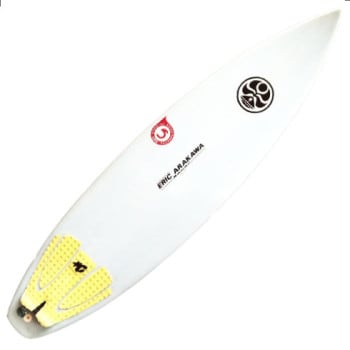
Salomon’s new S-core technology was inspired by aeronautic technologies, creating boards which are FLEXIBLE, PROFILED, LIGHT, and STRONG at the same time. The S-core construction method starts with a carbon fiberglass frame base which provides the stiffness necessary for speed and responsiveness. Three Polypropylene foam stringers are then glued to the carbon fiber frame to provide support and dampening. This completes the core structure of the board. The top layers consist of 4oz fiberglass and extruded polystyrene (EPS) foam. The EPS top coat provides a “soft” feeling under your feet, similar to that of a traditional PU board. Once the EPS foam/fiberglass topcoat has been attached to the core, the board is then given to the individual shaper for hand finishing. Once the board is finished by the shaper, it is then hand glassed by the laminator using epoxy resin. The motivation behind creating the s-core surfboard construction method was twofold. Firstly, this method produces a lighter, more durable board. Secondly, this method is much more environmentally friendly. The EPS foam used in producing S-core surfboards is CFC/HCFC free, 100% recyclable, PVC free and non-polluting due to the fact that it is dilutable into water and air. The epoxy resin used in producing these surfboards contains 4x less volatile organic compounds and is less toxic than the polyester resin used in traditional surfboard construction. Salomon is now working with a number of shapers and surfboard companies to construct S-core versions of their original surfboard designs. S-Core is no longer being produced as Salomon canceled the surf program.
Some key features regarding the S core:
- The S core surfboard is 10% stronger than a PU board,
- S-Core surfboard has 20% more flex and damping than a PU board,
- S-Core surfboard is made from extruded polystyren and is “blue”
The S core is not an Epoxy sandwich board (like Surf Tech).
• PRO: More responsive, lighter, stronger and faster than a traditional PU shortboard.
• CON: VERY high price.
• WHO RIDES THEM? Intermediate and advanced surfers.
NOTE: both Surftech and S-Core technologies were made popular after the Clark Foam crash when the biggest blank supplier closed its doors. Today the surfboard blanks market is a lot more balanced and epoxy boards are no longer a “NEW” thing.
The Vent (Firewire, Tuflite, S-Core and others…)
This is not a construction process, just some useful info: If you have a Firewire, Tuflite, S-Core (and others…) you might have noticed that your surfboard has a metal vent integrated into the deck. Why? Surfboards that are made using very light EPS foam contain lots of air, hollow surfboards even more. During temperature and air pressure changes (hot car – cold water, air travel…) air inside the surfboard can expand or contract considerably. The vent allows air to pass back and forth between the core and the exterior of the board when needed so no stress is put on the materials. Most vents are designed in such a way that this is done automatically. They have a GORE–TEX membrane that is permeable to air but waterproof. Just make sure the vent is clean and there is no wax in it. If your vent is not automatic make sure you open it to equalize the pressure when needed and then close it before going into the water.
If you have water inside your board you have either forgot to close the vent or your vent is broken and needs to be replaced.
Molded Surfboards (Pop outs)
Molded surfboards are also called Pop-Outs. The name Pop Out implies how they are made. Pop outs are not shaped but they pop-out of a mold that duplicates hundreds or thousands of surfboards. Molded surfboards construction process is the following: a female mold of a surfboard in two halves, top and bottom, is fiber glassed. The two halves are then brought together and liquid polyurethane foam is allowed to expand to fill the void in the center. The join line is later cleaned up and finished with a strip of special tape.
Molded surfboards are durable and hard to damage, the are shaped for the beginner surfers, so you can pick up waves easily. They are the surfboards that take you from a complete novice to basic level of surfing. The downside of the durability is weight – they are heavier than a custom board. This can cause problems for smaller and weaker surfers. Molded surfboards come in a range of shapes and sizes from shortboards to longboards, they are designed with lots of width, thickness and volume so they are stable and catch waves easily. Molded surfboards manufacturers: BIC, NSP, South Point…
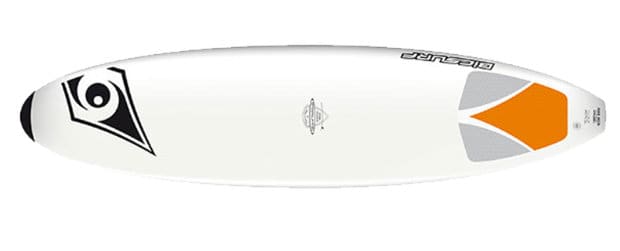
• PRO: Molded boards are cheap and durable, they are perfect for progressing from novice surfer to intermediate surfer – these boards are long, wide and thick so they are easy to paddle and catch waves easily.
• CON: Molded boards are heavier than custom boards and are unsuitable for high performance surfing. If dinged (which happens rarely) they can soak up water and become very heavy.
• WHO RIDES THEM? Perfect for beginner surfers.
Injection Molded Surfboards
Injection Molded Surfboards look very similar to pop-outs but are stronger and more important – lighter. They are also more expensive. The construction process is the following:
The core of the surfboard or a blank if you will is made in a mold with expanded polystyrene foam (E.P.S.). Expanded polystyrene foam is very light and at the end gives only about 10% of the total weight of the surfboard. EPS core is sometimes hand shaped to remove any irregularities, then it is laminated with multiple layers of fiberglass and epoxy resin. At the end, the surfboard is again placed into a mold where the thermoformed (P.V.T.) top sheet material is heat pressed to the top and bottom of the surfboard. Heat causes the top sheet to bond with the epoxy and for the epoxy to cure. This is the final addition that makes these surfboards extra strong and because of the light core not much heavier that ordinary custom surfboards.
Again these surfboard also come in a range of shapes and sizes from shortboards to longboards. In comparison to pop-outs they are more performance shaped and aimed at better surfers. Manufacturers that make them are pretty much the same that make pop-outs.

• PRO: Injection molded boards are lighter and offer better performance than a pop-outs, still they keep great durability and are available at a very good price in comparison with custom shaped surfboards. They are fast and easy to paddle.
• CON: They are more expensive than pop outs and still heavier that custom made boards.
• WHO RIDES THEM? They are aimed at beginners and intermediate surfers.
Soft Surfboards
These are made from a semi-rigid inner foam core blown in a mold which is covered with a soft foam exterior. They are very user friendly, they come in a variety of shapes and sizes and the Soft top surfboards are probably the most ideal surfboards to start on. They are shaped to have lots of volume and stability so you can catch lots of waves and be more stable when you are trying to stand up. They soft deck reduces the risk of accidents and injuries. All these are the reasons that soft surfboards are widely used in surf schools.
But if you are considering buying your own surfboard then perhaps a slightly more progressive surfboard would be more suitable. You can outgrow a soft surfboard quite quickly.

• PRO: Soft boards are extremely safe and generally very durable. They inspire great confidence in beginners. Soft surfboards are big, float well and you catch waves easily.
• CON: Soft surfboards are heavier than a traditional custom surfboards and progression with them is limited, they are only suitable for performing basic maneuvers.
• WHO RIDES THEM? First time surfers, children, surf schools.
Bodyboards
These are made in a similar fashion to softboards but are under 5ft in length and are designed to be ridden lying down or whilst crouching on one knee. They are ideal for beginners and experts alike and can be used in all types and sizes of waves.
Surfboard Types
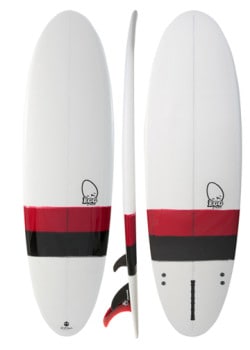 Are you searching for a new surfboard? Even more than construction, shape determines which surfboard is good for your surfing level and for the conditions you surf in. What kind of different surfboard types and shapes can be made using these construction techniques? This ultimate surfboard type guide explains surfboards from shortboards, longboards, hybrids, fishes to kneeboards, mini simmons, alaias and everything in between. And if you decided that you want a custom made surfboard then here are a few tips for you.
Are you searching for a new surfboard? Even more than construction, shape determines which surfboard is good for your surfing level and for the conditions you surf in. What kind of different surfboard types and shapes can be made using these construction techniques? This ultimate surfboard type guide explains surfboards from shortboards, longboards, hybrids, fishes to kneeboards, mini simmons, alaias and everything in between. And if you decided that you want a custom made surfboard then here are a few tips for you.

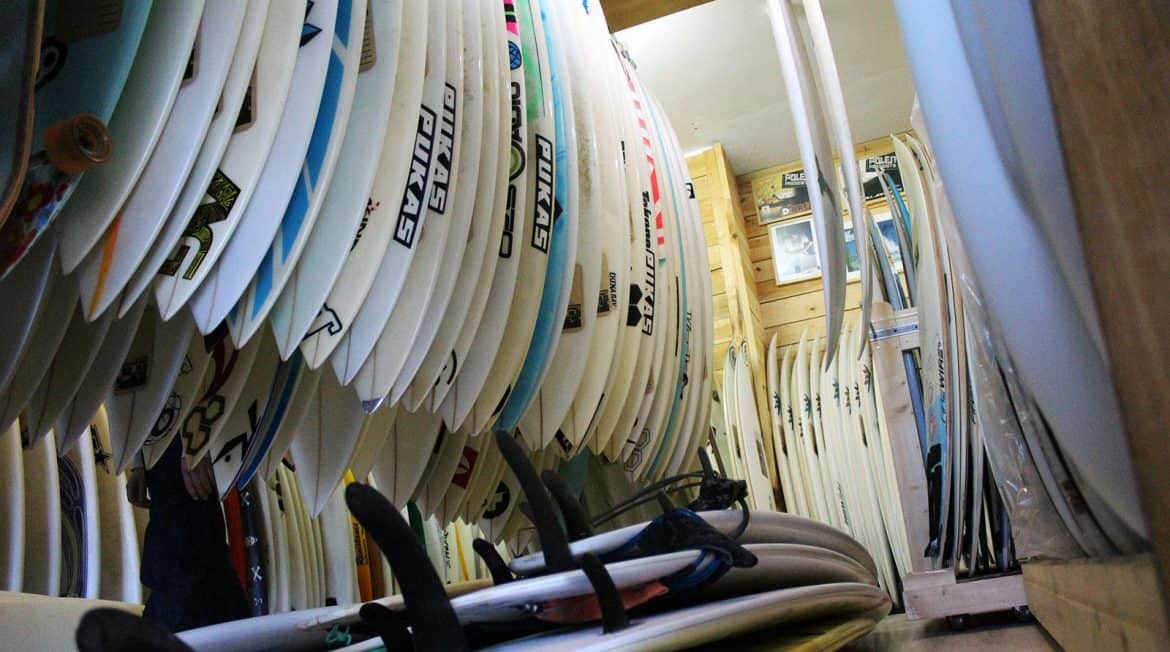
fire wire?
how can i make a mold to make plyurethane foam blanks? im a 21 year old that loves surfing and makeing boards and i want to make the blank the boards made out of so i can say i made it from ground up please right me back thank you?
my email is ss-bmf-spitfire03@hotmail.com
Hi Lew, ugh that’s a bit advanced :o I think first you need a shape that will become a model for your mold, usually you would cover the model with a special paste that prevents your mold from sticking to the model, but if you would take a foam blank as a model that paste might not work. Then you make a fiberglass mold around your model and reinforce it with steel wire. Make sure you make the mold in such way that the top and bottom part can be separated, so you can open it later. I’m not sure what kind of chemicals do you use to make foam, so fiberglass mold might not work :o I heard blank companies use concrete molds.
I used to make Styrofoam blanks but I ordered two pre-shaped Styrofoam blocks and glued the stringer in the middle.
Hope this helps ;)
Hi I’ve spray painted my blanc with acrylic paint, I don’t want it to bleed when I put on the resin as its red with white lines any ideas how to stop it?
@Andrew:
1. I heard that hair spray helps fixing the color (I never tried it).
2. Use air compressor (or something like that…) to blow away all the dust from your board.
3. If your acrylic paint layer is thin, you shouldn’t have to much bleeding, it’s worse if you have put on a thick layer of paint.
4. It also very much helps if you work quickly. Don’t push the resin over the same spot over and over again. One stroke to wet the fiberglass and second stroke to eliminate excess resin. This will reduce the problem.
I have a feeling that resin doesn’t actually dissolve the paint. But by pressing the resin into and up and down the fiberglass you break up the paint and little pieces of colored dust mix with the resin.
i dont know if this is the right place but i was hopeing u could help me, i have a 8′ soft top foam surfboard and i took care of it, it was not exposed to the elements when it wasnt in use andwhen i used it i washed it off and dryed it when i was done, it was standing upright in my garage and the (im guessing fiberglass) bottom and the foam top had come apart do you know why it would have done that and if there is any way to fix it? kit is about 4-5 years old but hasnt really been used to super much
@Krista: if your board was not exposed to the sun that much than I guess you can’t blame it on anything but bad construction, I had some similar experiences with foamboards where the whole bottom layer started peeling off. Then again 4-5 years is a decent age for a surfboard and probably the time when some of the glues used in surfboard construction start loosing their “grip”.
You can try and glue the foam layer back using an epoxy glue. Make sure you clean both surfaces really well before you do so, maybe even use some sandpaper on the polyester side.
hey, i just bought a channel islands s-core board. What does that object on the bottom of the board do, and how do you use it?
I think its a valve to regulate the pressure inside the board…like when it gets hot the air inside expands etc..
i’ve only used the CI Flyer S-Core one time and it got waterlogged. i dont know how, but i suspect it was through the thing that regulates the pressure inside the board. Is this Common? If not, how do i take the water out?
I just bought a bushman 6’10 in hawii. The glass dents when you barely press on it.
Could i put another coat of resin on it?
I’ve just got a second hand Webber Salomon S Core board and found that water is able to enter the board through what looks live a little valve at the bottom of the board (like Luca above). Is this normal and if so why does it happen? I have found out that i can get the water out through unscrewing the valve and emptying the water, but was wondering why it happens?
I have bought a cheap minimal after being without a board for a few years (married, kids, mortgage). It was in brand new condition but when i got it home i found out why it was so cheap. I have the same problem as pdid above and the glass dented as soon as i had a wipe out and knocked the board lightly. It only had 1 layer of glass and had been grinded back with really rough paper. I tried to get a quote to put a second layer of glass and resin on but was told it wasn’t worthwhile. It only has a couple of stripes of paint down the middle that i can quickly sand off. Could you give me some guidance to apply a second coat of glass, and is this practical.
The reason the eps and hollow boards are taking in excessive water is because they are being put in the water while in a heated state. The cooling down when dropped in the water causes them to contract and suck in water, though the valve is supposed to be one way. I find when repairing an eps core board, it must be glassed while temperature is dropping or the expanding air (if the temp is rising) will cause the resin to bubble out and leave pinholes in the repair. Eps boards will delaminate when exposed to high heat even though they are not in direct sun, due to this same expansion issue, such as Krista’s board.
I have an s-core with one of those valve things, the screw was really tight one day, and i used to much force and now the whole thing is loose like the screw and the fitting attached to the deck, am i up shit creak? Im thinking some epoxy resin around the edge of the valve to seal it? will this work?
Where can I find styrofoam cores for board construction? And how do you shape the styrofoam to needs??
You shape styrofoam pretty much as you would a normal blank… just be a bit careful because of the different structure of the foam…